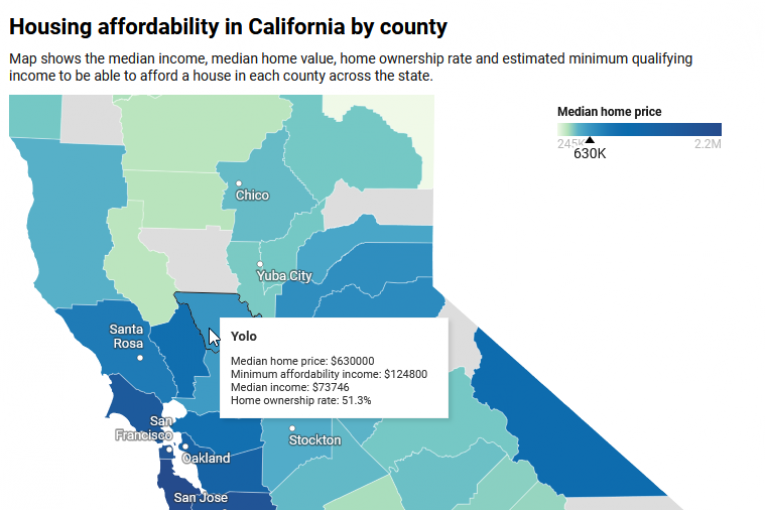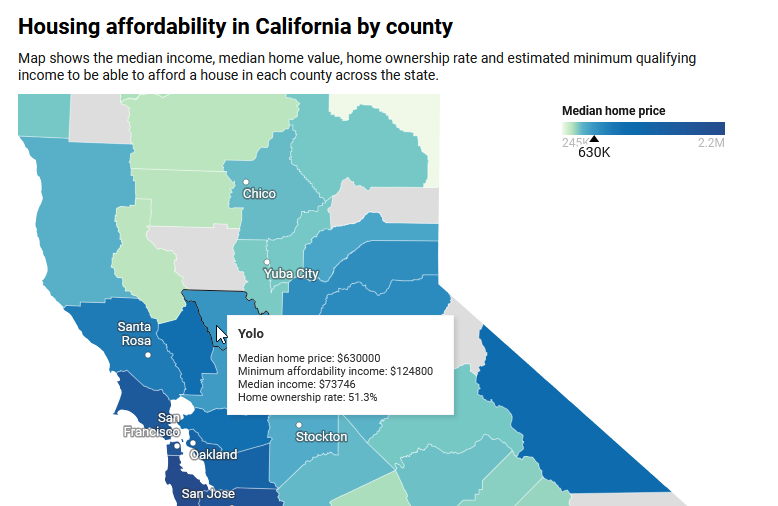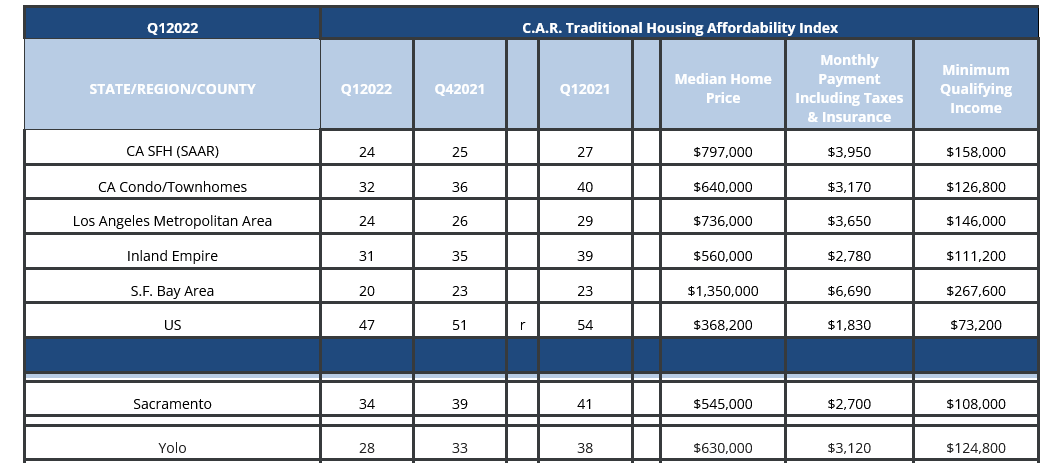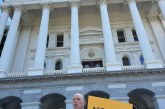

By David M. Greenwald
Executive Editor
This week we have cited a number of studies to show that the housing crisis is multifaceted, it exists across the nation, and it is present both in the rental market for apartments as well as the housing market.
A new report shows that California’s home ownership rate is the second lowest in the nation behind New York, according to the US Census Bureau. Indeed, from 2016 to 2020 (note this is before the pandemic even), around half the counties had ownership rates of less than 60 percent and in places like Los Angeles (46) and San Francisco (38) it was even worse.
Data from The California Association of Realtors and its quarterly housing affordability index shows the gap between home prices and the estimated income needed to purchase a median valued home.
I focused in on the data for Yolo County. And remember, if anything this understates the severity of the problem because in Davis the problem is going to be far worse.
But countywide, the median home price was $630,000 over this time. To understand just how much the point is understated, according to Zillow, the typical value of homes exceeds $900,000, so it’s nearly 50 percent higher than the value of homes in the county overall.

In order to afford the $630K home, you would need to make around $124,800 per year. The median income in the county is around $73746 and the home ownership rate is 51.3 percent.
If we look at just Davis, assuming $900,000, it puts Davis on par with Contra Costa County. In Contra Costa, one must earn about $180,000 to afford the $4500 monthly payment.
Davis doesn’t compare to Bay Area counties like San Francisco ($1.8 million), San Mateo ($2.2 million) or Santa Clara ($1.9 million) but Davis is a good deal higher than the average in California and far higher than the US national average of $368,000.
Does this matter?
Obviously it depends on who you ask. Those who already own homes in Davis and want to keep the town small and limit growth, may prefer a higher barrier to entry.
On the other hand, I am concerned that dynamics in the community are now out of kilter. We have seen declining enrollment, the impact on the schools, an aging population base and more reliance on things like parcel taxes to fund our schools.
We should also be concerned with the jobs-housing balance and the fact that a huge percentage of employees at UC Davis cannot afford to live in Davis, but instead have to commute from areas where housing costs are less expensive.
For those concerned about climate change and the environment – while people have prioritized preservation of open space and agricultural land – on Davis’ periphery, demographic trends mean that farmland elsewhere is getting developed and people are having to commute from distance to get to work both people who work at UC Davis and people who live in Davis and have to rely on jobs to support their high costs of living.
Put that all together and it is not clear that the environment is actually overall benefitted from our current land use policies.







“Put that all together and it is not clear that the environment is actually overall benefitted from our current land use policies.”
Policies you support.
Some folk don’t understand the concepts of ‘trade-offs’, and ‘priorities’… the first is factual, the second is subjective, and an individual might be ‘conflicted’, and/or “just want to have it all!”
And want fries with that, to boot.
You keep making the point over and over again without considering the different between process and outcomes. I support the democratic process even when/ though it doesn’t always produce the outcomes I prefer.
David G
We need to have a balanced democratic process. Having citizens vote on every single decision, e.g., where to put a stop sign, would basically bring our society to a standstill. We also have an electorate that can’t be informed about every issue. Instead, we’ve delegated decision making through a democratic republic and in order to keep our representatives accountable we need to fully delegate responsibility to them. We undermine one democratic institution (government officials) by being overly reliant on another (direct decision making through initiatives/referendums). We’ve seen this problem at the state level–it isn’t unique to Davis. Democracy is much more complicated than simply having a vote. I suggest that you reexamine your position on whether Measure J created a process that leads to good democratic governance. I submit that it has been counterproductive at a broader level.
Is that part of Measure J, too?
Right – because council members like Gloria and Dan are “land-use” experts, unlike the “ignorant, unwashed masses” that you want to disenfranchise.
And it’s “so difficult” to decide whether or not to continue sprawling outward onto prime farmland outside of city limits, and/or understand what creates housing shortages by adding 2,500 claimed jobs, but only 460 housing units. Only “real experts” can make such calls.
We do see it at every level – the entire system is corrupted by special interests. Even the initiative/referendum process favors special interests, since they’re the only ones with sufficient money to get something on the ballot.
This is also the reason that folks like Wiener are elected, as well as the reason that the “choices” (in regard to candidates and issues) are restricted in the first place.
It doesn’t really matter whether or not you (or David) keep pushing to disenfranchise Davis voters from decisions regarding paving over prime farmland outside of city limits to accommodate more urban sprawl. (Keep trying – I find it amusing.)
Schools mentioned twice in the same sentence. I have no idea why David or anyone else thinks that the desires of an oversized school district should be driving city planning.
I assume this is primarily focused on “North, North Davis” (as the developer himself named it). What I’d suggest is that Woodland enact a Measure J-type proposal. Short of that, there’s nothing that anyone can do to change this, as those in charge of that city largely support sprawl.
But again, it’s probably an easier and less-impactful commute from “North, North Davis” to UCD than it would be from any of the proposed peripheral sites outside of Davis.
Already, housing prices in Spring Lake pretty much start in the mid-$600s for a traditional single-family house. How much do you suppose one of those would be in a peripheral development on peripheral land just outside of Davis?
It seems that you can can a much better “deal” on pre-owned housing. I recently saw a perfectly fine one in Davis, listed for $630K.
On a broader level, the housing market is crashing – as reported in the news every day. In response, builders are drastically cutting back production.
Maybe folks just need to accept that housing ain’t cheap, anymore, due a number of factors (including inflation). Though there are places in the country where the salary-to-housing costs are better-balanced, then they are in California. (I just saw an article regarding that.)
And in places like San Francisco, they’ve actually been losing population. When do you suppose they’ll start tearing down housing there, to match the decline? (The state itself has also been losing population.)
By the way, what’s with the “pop-up” ads that are now appearing on the Vanguard?
“Crashing” is in the eye of the beholder… except perhaps in 1929…
A “leveling”, or a 4-5 % reduction in current value is not a “crash” in my view… unless of course you think of your home as an investment, that you expect/want to grow @ 10-15%/yr…
I don’t… yes, it is an asset, dearly paid for… but had I put the same $$$ (over a lease/rent) over the last 45 years in mutual funds, etc., given the mortgage interest (only deductible @ like 15 cents on the dollar, at most), we’d be ‘better off’… we still would have been housed, still have had the amenities… but it was a choice we made, and turned out well. Past performance is no guarantee of future results… have been following that ‘mantra’ for over 40 years…
“Ownership” of property/housing MIGHT have advantages, particularly in housing when one no longer has a steady stream of income, and want to be ‘secure’ in housing… but the idea that owning housing for oneself, for building wealth, or the concern/advocacy about “crashing” [BS] is largely ephemeral…
I call BS on your assertion, Ron O….
This article from Time shows the problem and why the housing market isn’t likely to swing in buyer’s favor.
It’s not my “assertion”, and you know that (unless all you read is the Vanguard).
The following type of information can be found in the mainstream news, literally every single day (and in multiple sources). This took me 5 seconds to find, and no – I didn’t even read it beyond the title.
https://www.marketwatch.com/story/scary-times-builders-cut-home-prices-and-slow-construction-as-buyers-pull-back-survey-shows-11657567086#:~:text=There%20are%20couple%20of%20reasons,home%20builder%20morale%20is%20sinking.
Point out again the issue is stabilizing enrollment year over year, not the baseline size of the district.
Needs change, over time – as you’ve pointed out. Including the “baseline” need. You don’t build an oversized school district, and then demand that the city adjust itself to that.
If they weren’t poaching students from Woodland, the need to change the assumed “baseline” would have been forced-upon the school district a long time ago.
And even if more housing is built, the underlying issue would still not be resolved. That is, unless housing turns over, existing residents eventually age-out of the system. That ultimately goes for “new” housing, as well. (And that’s assuming that young families would be the ones buying the new houses in the first place. Remember The Cannery?)
Again, you seem to think the school district’s “needs” should be driving city planning. Folks that push for sprawl to temporarily avoid “right-sizing” the district are ultimately undermining support for the school district, itself. Creating a battle between slow-growth advocates, vs. a self-interested school district.
And, silly me, I thought the point was ‘education’… not stabilizing enrollment (or DJUSD employment?), or ‘baseline size of the district’… silly me.
But David G and Ron O know better what the REAL issues are… costs, enrollment numbers, baseline size… I defer to the “experts”…
And, they may not… I do not, and we own our home, free and clear (of mortgage)… and consider it housing, not an “investment”, nor as essential to “building wealth”…
The quoted part is borderline “profiling”…
Ron O oft seems to say ‘I’ve got mine!’ [and I don’t care about ‘others’], David G oft seems to say ‘I want mine!’ [and, I want others to pay for it, make it happen], and both couch it in other terms… one ‘protecting the environment’, the other in ‘social justice’…
Whatever…
Interesting “take”, though I don’t think it’s accurate (in either case). I don’t think that either one is “couching” the issue in other terms. (Though I believe that one is putting the desires of the school district first.)
As far as those who (don’t “have already theirs”), I don’t think that California is the best place to make that happen, even when the housing downturn ends. The following article is not the one that I read the other day, but (from the title alone) seems to make the same point:
https://www.fool.com/the-ascent/research/10-best-cities-high-salaries-low-cost-living/
If I had to guess, I’d estimate that half of those in the Sacramento region (including Davis) came from places where housing costs were higher (mostly, from the Bay Area). But as prices have predictably climbed, even the Sacramento region is probably not the best place to move to, at this point.
Wait for the housing crash to “do its thing”, before buying a house. (And even then, it certainly won’t be in Davis for those starting out.) Davis housing prices generally don’t crash as much as other places in the region.
I’m failing to see the “problem” with this. Again, Davis (and region) “used to be” the place for relatively cheap housing, but those days ended some time ago. And even in pre-Measure J days, Davis was more expensive than nearby communities. Though now, the total price seems like “chump change” – everywhere.
That used to be true in places like San Francisco, as well. For that matter, Adolph Sutro probably owned half of the city at some point. (Purchased for “chump change”.) Of course, it helps if you’ve made a fortune in mining in Nevada, first.)
These days, you might want to speak with Zuckerberg, etc. (He apparently/recently sold his S.F. house for a handsome profit – even as the population has declined.)
I was thinking about what Davis would be like today without Measure J. There would likely be a few thousand more housing units completed and occupied with many more family homes producing children. We would be a healthier community socially. Home prices and rents might even be marginally lower because of locally added supply even though regional demand would still have a dominant influence on the housing market. Many people might have a smaller distance to travel to work than they do today if they work in Davis. We would need more infrastructure and we would lose some farmland production but overall I believe we would be a better community.
Measure J is one of the worst things to ever occur in Davis. It has vastly inflated housing costs for all types of housing. It’s simple economics. Demand far exceeds supply. It’s also bad for climate change. The more people have to commute to school and work, the more pollution is created. Traffic jams are even worse.
Supply and demand are generally in equilibrium. If you list a house for $1 (almost anywhere), “demand” will almost certainly exceed “supply”.
I read somewhere that a similar thing occurred, when a gas station attendant mistakenly listed the price for a gallon of gas for something like 69 cents. (He was apparently fired, as a result.) Regardless, “demand” certainly exceeded “supply” in that case.
Conversely, if you put a sale price of $2 million dollars for a house in Natomas, Woodland, Elk Grove or Stockton, “supply” might exceed “demand”.
I’m pretty sure that there are more people are commuting “out of” Davis (e.g., including to UCD and Sacramento), than are commuting “to” Davis.
And a commute from somewhere like the DiSC site (through town – to UCD) is no more efficient than commuting to UCD from Spring Lake.
If folks don’t like the “supply/demand” model, make they should work toward changing capitalism, itself.
If supply and demand were in equilibrium housing prices and rents would not be going up.
And Davis would look like Elk Grove. What a lovely vision.
“Equilibrium” does not mean “no change”. Prices change all the time – not just in the housing market.
“Supply” can (and does) increase or decrease, without even building an additional stick of housing. Supply is increasing now (across the country), as more existing houses come on the market (and don’t sell).
“Demand” also can (and does) increase or decrease – again – without even building an additional stick of housing.
“Supply” also generally includes housing in nearby communities.
Yeap. But in addition to that, housing prices had been rising quickly in Elk Grove (and throughout the region and country). I believe they actually were rising faster than they have in Davis.
And now, housing prices are on their way down, largely due to the rise in interest rates. Since that was predicted in the media, a lot of buyers apparently “rushed” to purchase houses, right before the interest rates went up. Thereby driving up housing prices.
A long time ago (even before Measure J), I recall that a real estate agent said that housing prices in Davis don’t fall as much as they do in surrounding communities, during downturns. (Nor do they rise as quickly during housing booms.) And based upon what others have posted on here, the data backs that up.
The present equilibrium is very disadvantageous to renters and to those who wish to buy homes in Davis. That includes a large number of people who work here who have to live elsewhere due to insufficient inventory. That’s really the whole point of these discussions.
The 1% growth cap would have allowed several hundred more homes over the last decade. But Measure J is one of the reasons those homes don’t exist.
As already noted, Davis apparently has a net exodus of workers on a daily basis (e.g., to UCD and Sacramento).
There are more people commuting “out” of the city, then there are commuting “to” the city.
Though it would be interesting to know what the impact of telecommuting is, regarding commutes.
As far as long-term renters are concerned, that’s what rent control is for. (And it already exists in a limited way, across the entire state.) Maybe those concerned about renters should be advocating for this to be strengthened. Especially since rent (AND housing prices) have been rising EVERYWHERE.
Though again, “for-sale” housing prices are now on their way down.
It’s pretty challenging to advocate for more housing, when prices are dropping and builders are pulling back.
I’m not concerned about that. I’m concerned about the disproportionate impact of the restrictive housing outcomes on demographics who can least afford it. This is why workforce housing is the current focus of these discussions. I believe there is a growing consensus that we need more workforce housing here.
Davis voters have shown a willingness to approve housing for certain demographics. Workforce housing will likely be the next focus.
Rent control ultimately reduces housing supply, can adversely affect maintenance, and really only benefits long-term renters. People in the workforce, and young adults, tend to move more often and face ever-increasing rents.
Short-term fluctuations in the housing market are irrelevant to long-term planning discussions.
I don’t think the “workforce” that you’re referring to has actually been defined in terms of where they’re working (or tallied, regarding the actual number who would then “presumably” move from wherever they’re living). As an example of this lack of definition, some may define the “workforce” as those working at UCD.
In any case, it seems that you are referring to Affordable housing, which depends upon government funding. And (like any housing), is generally not “reserved” for particular groups (e.g., particular “workers”).
It would be useful see a cost analysis (to the city), as a result of adding more Affordable housing (before blindly embarking upon it).
Most rent control ordinances exempt newly-built apartment complexes, and allow for (actual) costs to be passed onto renters.
If Costa Hawkins was ever repealed, cities could also regulate rent increases for currently-vacant units.
I find it odd that some folks who claim to be concerned about (unreasonably) rising rents oppose rent control.
Adding more housing units increases the size of a city, but does not generally lower housing prices for an existing “workforce”.
And whenever I read the Vanguard, all I actually see is an advocacy to increase the size of the city.
That’s partly due to them wanting to have them as ownership units, with fixed, sub-market/zero interest mortgages so they can build wealth… one can opine as to who pays for that outcome, and whether it is reasonable or not.
No… untrue…
The VG wants to be all things to all people, yet generate controversy, get “hits”, build revenue… a business model… something a ‘fiscal conservative’ should love… [edited]
Perhaps a refresher on the law of supply and demand is in order:
https://www.wallstreetmojo.com/law-of-supply-and-demand/
Equilibrium prices showcase the price at which supply and demand are equal and satisfying in the market.
From your link:
(In other words, demand is not “fixed” – and depends upon price.)
(In other words, if you offered a high price, you’d find more homeowners willing to sell.)
If you look at Zillow at any given point in time – you’ll find housing for sale or rent which is likely very close to “equilibrium”. The final, negotiated price is essentially the “equilibrium”, in most cases.
You’d also have to define what “demand” and “supply” actually mean. For example, buyers will look for alternatives, if they’re unwilling or unable to purchase or rent at equilibrium. In which case, “supply” may include surrounding areas (or other areas entirely). This is a primary reason that California itself has been losing population to places like Texas.
Supply and demand is not necessarily/uniquely defined by only one alternative. Davis is not the only city in the world (and in my opinion, is nowhere even near the most-desirable locations).